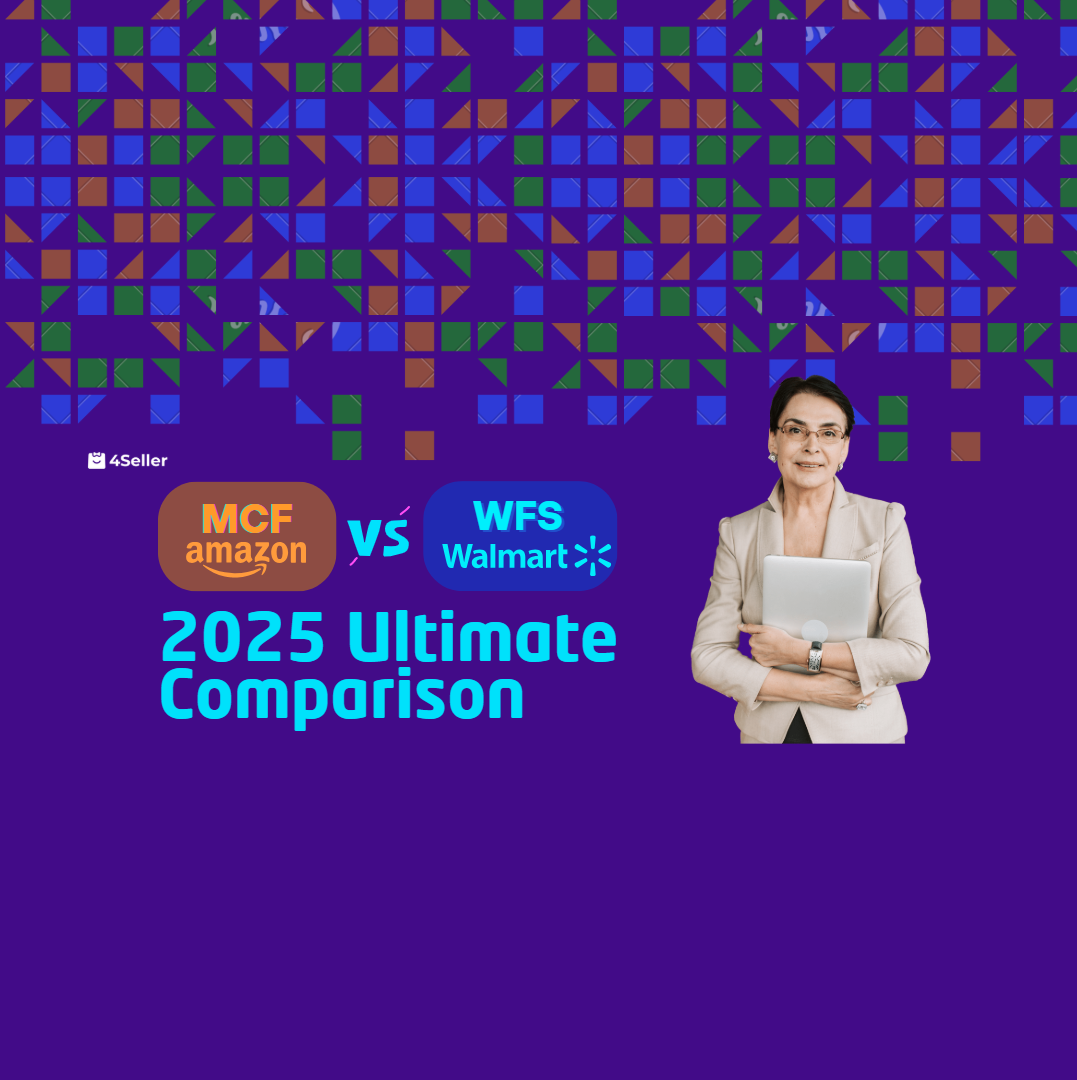- Order Management
- TikTok Shop
- Temu
- About 4Seller
- Amazon
- Shopify
- Inventory Management
- Amazon MCF&FBA
- Amazon Shipping
- UPS
- FedEx
- DHL Express
- Creator Bulk Invite
- Listing Management
- Seller Tips
- eBay
- GLS
- Walmart
- Amazon MCF
- Shein
- Royal Mail
- Multi-channel Store
- Marketplace News
- PayPal Tracking Sync
- Poste Italiane
- OTTO
- Shipping Integration
- Stripe Tracking Sync
- UniUni
- USPS
- Yodel
- Inventory Sync
- Beginner Tutorial
- CaiNiao
- BRT
- Chronopost
- CIRRO
- Correos
- Correos Express
- Logistics Rule
- Deutsche Post
- DHL Parcel
- Etsy
- Evri
- GOFO
- Kaufland
- Shipping Label
- Walmart WFS
- WooCommerce
- AliExpress
- Cdiscount
- DHL
- DPD
- Platform Integration
- OMS
Amazon MCF vs Walmart WFS for Multi-Channel Sellers (The Ultimate 2025 Comparison)
 By Joline15 Oct,2025
By Joline15 Oct,2025
In 2025, operating across multiple e-commerce platforms has become the new normal. Many merchants now sell on Amazon, Walmart, Shopify, and even TikTok Shop simultaneously — but profitability increasingly depends on fulfillment efficiency and cost control.
Two of the most competitive fulfillment options available to U.S. sellers are Walmart Fulfillment Services (WFS) and Amazon Multi-Channel Fulfillment (MCF). Both leverage world-class logistics infrastructures, but their economics and ecosystem fit differ significantly.
This article provides a professional, data-driven comparison between WFS and MCF — and explains how 4Seller ERP helps merchants automatically choose the most cost-efficient and time-optimized fulfillment route.
I. Overview: Understanding WFS and MCF1. What is Walmart WFS?
Walmart Fulfillment Services (WFS) allows sellers to store inventory in Walmart-operated fulfillment centers, where Walmart handles picking, packing, shipping, and returns on the seller’s behalf. Fees are calculated by item weight, size, and storage duration.
According to Walmart, WFS can be “up to 15% cheaper than competitors on average.”
👉 Reference: Walmart Fulfillment Services2. What is Amazon MCF?
Amazon Multi-Channel Fulfillment (MCF) lets sellers use Amazon’s FBA (Fulfillment by Amazon) warehouses to fulfill orders from non-Amazon sales channels such as Shopify, TikTok Shop, or eBay. It offers the same logistics infrastructure and carrier network as FBA.
👉 Reference: Amazon MCF3. Why Compare Them?
For multi-channel sellers, fulfillment decisions directly affect gross margin, delivery performance, and customer satisfaction.
Choosing between WFS and MCF — or combining both through automation — can yield double-digit savings in operational costs.
II. Cost Comparison: WFS vs MCF1. Fulfillment (Pick, Pack, Ship) Fees
| Weight / Type | Walmart WFS | Amazon MCF |
|---|---|---|
| ≤ 1 lb (Standard Item) | From $3.45 | Slightly higher; includes full pick-pack-ship service |
| 2 lb | Around $4.95 | Similar range |
| 3 lb | Around $5.45 | Comparable or slightly higher |
| 4–20 lb | $5.75 + $0.40 per lb beyond 4 lb | Pricing varies based on zone and service speed |
| Oversized / Bulky | Special tiered rates apply | Often less cost-effective for large or heavy items |
👉 Reference: Walmart Fulfillment Services Pricing Guide
Amazon’s MCF fees fluctuate depending on the fulfillment center network, service level (Standard / Priority), and seasonal demand.
A recent Flow.Space analysis noted that MCF pricing in 2024–2025 increased due to labor and logistics cost inflation, while Walmart maintained flatter fee tiers.
— Flow.Space, “Multi-Channel Fulfillment Comparison Report,” 2024
2. Storage Fees
| Period | WFS | MCF (FBA Network) |
|---|---|---|
| Jan–Sep | $0.75 per cubic foot | Slightly higher, typically $0.87–$0.99 |
| Oct–Dec (Peak Season) | $1.50 per cubic foot | Up to 2× base rate; long-term storage penalties apply |
Long-term inventory (over 365 days) incurs higher surcharges under FBA/MCF than WFS.
Walmart’s simpler pricing structure makes WFS more predictable for stable SKUs with slower turnover.
3. Returns & Additional Fees
| Fee Type | WFS | MCF |
|---|---|---|
| Return Handling | Standard fee based on item weight | Seller-funded; may include reverse logistics cost |
| Labeling / Prep | Non-compliant packaging incurs small prep fee | Same applies for FBA inbound errors |
| Oversize / Dangerous Goods | Case-by-case | Case-by-case |
Walmart’s documentation emphasizes strict packaging and labeling standards. Amazon MCF enforces similar rules but can penalize violations more heavily due to FBA inbound congestion.
III. Fulfillment Speed & Network Reach
| Dimension | Walmart WFS | Amazon MCF |
|---|---|---|
| Average Delivery Speed | 2–3 days (2-Day Coverage in most regions) | 1–2 days via Amazon’s FBA network |
| Geographic Coverage | Expanding across major U.S. regions | Nationwide + EU cross-border options |
| Multi-Channel Compatibility | Walmart Marketplace only | Works with TikTok, Shopify, eBay, Etsy, etc. |
| Operational Consistency | Centralized under Walmart system | Slight seasonal volatility under peak loads |
A 2024 Amazon Supply Chain report revealed that sellers using FBA + MCF saw a 38% increase in total Amazon sales due to improved logistics reliability and buyer confidence.
IV. How 4Seller Automates Smart Fulfillment Routing
Manually deciding between MCF and WFS per order is impossible at scale.
That’s where 4Seller ERP enables intelligent automation, allowing sellers to optimize every fulfillment decision dynamically.
1. Smart Fulfillment Rule Engine
Sellers can set rules such as:
-
“Use WFS for all Walmart orders.”
-
“If SKU inventory < threshold in WFS, auto-route via MCF.”
-
“If destination ZIP is covered by Amazon’s 1-Day delivery, prioritize MCF.”
4Seller evaluates real-time costs, inventory levels, and delivery zones to select the optimal route.
2. Unified Order & Label Dashboard
All orders from Amazon, Walmart, TikTok, and Shopify appear in one 4Seller dashboard — with centralized label printing, bulk shipment, and unified tracking updates.
3. Real-Time Inventory Sync
WFS, Amazon FBA/MCF, and platform stock levels are synchronized automatically to prevent overselling and eliminate out-of-stock cancellations.
4. Fulfillment Cost Analytics
4Seller generates detailed reports comparing WFS vs MCF costs, fulfillment times, and warehouse utilization — helping teams continuously refine their fulfillment mix.
V. When to Use WFS vs MCF (or Both)
✅ Best Use Cases for WFS
-
Primary focus on Walmart Marketplace sales
-
Standard-sized products with stable sales volume
-
Sellers prioritizing cost control over 1-day delivery speed
✅ Best Use Cases for MCF
-
Multi-platform operations including TikTok, Shopify, or eBay
-
Products requiring fast or premium shipping options
-
Sellers seeking scalability and automation across multiple sales channels
✅ Hybrid Strategy (Recommended)
Leading brands combine both networks — using WFS for Walmart orders and MCF for external marketplaces.
4Seller’s automation makes this possible seamlessly: the system routes each order to the cheapest and fastest fulfillment option without manual input.
VI. Key Takeaways
In 2025, WFS and MCF are not competitors — they are complementary tools in a smart seller’s logistics stack.
-
WFS offers cost stability and deep integration with Walmart Marketplace.
-
MCF provides unmatched reach, speed, and cross-platform flexibility.
-
4Seller ERP enables sellers to use both simultaneously — automatically optimizing per order for speed, cost, and inventory availability.
Rather than locking into a single fulfillment model, top sellers in 2025 will rely on fulfillment flexibility and automation to scale profitably across platforms.
In the era of operational efficiency, success favors those who route smarter, not just ship faster.
Stay Connected with Me & 4Seller
If you found this guide helpful and want to stay ahead in e-commerce automation, follow me for more insights on:- TikTok Shop optimization
- Amazon MCF & FBA strategies
- Multi-channel inventory automation
- Real case studies from global sellers
📩 Business Inquiries / Partnership:
Email: [email protected]
🌐 Official Website:
www.4seller.com/signUp.html?source_code=n6gwnpjjw0
🔗 Follow 4Seller on Social Media:
- LinkedIn: https://www.linkedin.com/company/4seller-erp
- Facebook: https://www.facebook.com/erp4seller/
- YouTube: www.youtube.com/@4seller
Exchange insights with 5,000+ e-commerce sellers sharing real growth strategies:
👉 https://chat.whatsapp.com/HZmWyTxfiiVG0jb96e26Dy
Written by Joline Chan — E-commerce growth strategist & SaaS content creator.
Follow me for practical guides on TikTok Shop, Temu, and Amazon seller automation.
- Order Management
- TikTok Shop
- Temu
- About 4Seller
- Amazon
- Shopify
- Inventory Management
- Amazon MCF&FBA
- Amazon Shipping
- UPS
- FedEx
- DHL Express
- Creator Bulk Invite
- Listing Management
- Seller Tips
- eBay
- GLS
- Walmart
- Amazon MCF
- Shein
- Royal Mail
- Multi-channel Store
- Marketplace News
- PayPal Tracking Sync
- Poste Italiane
- OTTO
- Shipping Integration
- Stripe Tracking Sync
- UniUni
- USPS
- Yodel
- Inventory Sync
- Beginner Tutorial
- CaiNiao
- BRT
- Chronopost
- CIRRO
- Correos
- Correos Express
- Logistics Rule
- Deutsche Post
- DHL Parcel
- Etsy
- Evri
- GOFO
- Kaufland
- Shipping Label
- Walmart WFS
- WooCommerce
- AliExpress
- Cdiscount
- DHL
- DPD
- Platform Integration
- OMS
- 17 Dec,2024
- 17 Dec,2024




